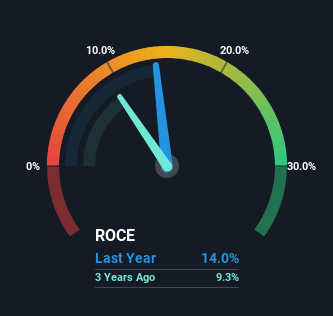Be Wary Of Lucky Harvest (SZSE:002965) And Its Returns On Capital

If you're not sure where to start when looking for the next multi-bagger, there are a few key trends you should keep an eye out for. Firstly, we'll want to see a proven return on capital employed (ROCE) that is increasing, and secondly, an expanding base of capital employed. Basically this means that a company has profitable initiatives that it can continue to reinvest in, which is a trait of a compounding machine. In light of that, when we looked at Lucky Harvest (SZSE:002965) and its ROCE trend, we weren't exactly thrilled.
What Is Return On Capital Employed (ROCE)?
If you haven't worked with ROCE before, it measures the 'return' (pre-tax profit) a company generates from capital employed in its business. The formula for this calculation on Lucky Harvest is:
Return on Capital Employed = Earnings Before Interest and Tax (EBIT) ÷ (Total Assets - Current Liabilities)
0.14 = CN¥436m ÷ (CN¥6.0b - CN¥2.9b) (Based on the trailing twelve months to September 2023).
Thus, Lucky Harvest has an ROCE of 14%. On its own, that's a standard return, however it's much better than the 6.1% generated by the Machinery industry.
See our latest analysis for Lucky Harvest

In the above chart we have measured Lucky Harvest's prior ROCE against its prior performance, but the future is arguably more important. If you're interested, you can view the analysts predictions in our free analyst report for Lucky Harvest .
What Does the ROCE Trend For Lucky Harvest Tell Us?
When we looked at the ROCE trend at Lucky Harvest, we didn't gain much confidence. Around five years ago the returns on capital were 23%, but since then they've fallen to 14%. However, given capital employed and revenue have both increased it appears that the business is currently pursuing growth, at the consequence of short term returns. And if the increased capital generates additional returns, the business, and thus shareholders, will benefit in the long run.
Another thing to note, Lucky Harvest has a high ratio of current liabilities to total assets of 48%. This can bring about some risks because the company is basically operating with a rather large reliance on its suppliers or other sorts of short-term creditors. While it's not necessarily a bad thing, it can be beneficial if this ratio is lower.
The Key Takeaway
While returns have fallen for Lucky Harvest in recent times, we're encouraged to see that sales are growing and that the business is reinvesting in its operations. In light of this, the stock has only gained 1.0% over the last three years. Therefore we'd recommend looking further into this stock to confirm if it has the makings of a good investment.
If you want to know some of the risks facing Lucky Harvest we've found 2 warning signs (1 doesn't sit too well with us!) that you should be aware of before investing here.
For those who like to invest in solid companies, check out this free list of companies with solid balance sheets and high returns on equity.
New: AI Stock Screener & Alerts
Our new AI Stock Screener scans the market every day to uncover opportunities.
• Dividend Powerhouses (3%+ Yield)
• Undervalued Small Caps with Insider Buying
• High growth Tech and AI Companies
Or build your own from over 50 metrics.
Have feedback on this article? Concerned about the content? Get in touch with us directly. Alternatively, email editorial-team (at) simplywallst.com.
This article by Simply Wall St is general in nature. We provide commentary based on historical data and analyst forecasts only using an unbiased methodology and our articles are not intended to be financial advice. It does not constitute a recommendation to buy or sell any stock, and does not take account of your objectives, or your financial situation. We aim to bring you long-term focused analysis driven by fundamental data. Note that our analysis may not factor in the latest price-sensitive company announcements or qualitative material. Simply Wall St has no position in any stocks mentioned.
About SZSE:002965
Lucky Harvest
Engages in the research, development, production, and sale of precision stamping dies and structural metal parts in China.
Excellent balance sheet with reasonable growth potential.
Market Insights
Community Narratives



